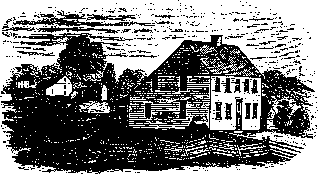

We make another side trip from Waterbury to cover Watertown, settled about 1701. A parish of Westbury in Waterbury was organized in 1738, and the present town incorporated in 1780. Watertown is a high hill country, famous in early days for its breed of "Connecticut Red" oxen and Gen. Humphreys' merino sheep. In addition to local manufacturing and school interests, there is a considerable suburban and summer colony.
Leaving Waterbury by R. 73 along Steel Brook, we pass through the manufacturing village of Oakville, with a large pin factory and other concerns making wire goods and pruning shears. In Watertown, the Hemenway Silk Co. has been making silk thread since 1849, and there are rayon and shellac plants. Nathaniel Wheeler, one of the pioneers in the development of the sewing machine, was born here, and organized the Wheeler and Wilson firm in 1851, moving to Bridgeport five years later. Another early industry was the making of palm leaf hats.
As we enter the village, the Belden Hoose stands on our nght, dating from 1715. A little east of Main St. is the *Bishop Tavern, originally standing on Academy Hill, a large Colonial house with gambrel roof and an overhang in both stories, said to have been built in 1800 though it appears much older. Other old landmarks are the Gen. Garrett Smith House (Dailey House) of 1778, on the left side of Main St., a small gambrel-roof building with 2 chimneys and a modern porch; Younglove Cutler House 1793, on the left of U.S. 6, is the center; and Rev. John Trumbull House (Woodward Tavern) next the Library, built in 1772, and later enlarged to serve as an inn. Beyond the Green. on U. S. 6, is the Taft School, founded by Horace D. Taft in 1890 in Pelham Manor and moved to Watertown in 1893. The main building, of brick and limestone, was designed by Goodhue.
Lake Winnemaug lies 2 miles southwest of the village, by Cherry Hill Rd. west of R. 63 to Litchfield, in the Guernseytown district near the town line, on the old road to Bethlehem, we find an attractive wooded ravine. About a mile east of H. 63 on Linkfield Rd., is the charming Smith Pond.
The most beautiful drive is by U. 5. 6 to Thomaston, which follows down Purgatory Brook through Mattatuck State Forest. In about 3 miles, a path on our right, turning off by an oId gravestone, leads in 1/4 mile to Leatherman's Cave, under a cliff in the intervale, one of the stopping places of the celebrated Leatherman, whom we have met elsewhere. This hermit wore clothing of leather scraps, and made periodic trips through western Connecticut and New York, until his death in 1889. A little farther, on our left, is the Roberts Memorial, a natural monolith with a tablet to Harley F. Roberts of Taft School, who was the leader in securing through gifts the present State Forest, established in 1926. The portion of the Forest most used by the public has been organized as *Black Rock State Park, which lies at the foot of the slope, with the beautiful Sand Dam Pond below the cliff.
The blue marked Mattatuck Trail, coming down from Mohawk Mt. skirts the west shore of the Lower Waterbury Reservoir, in the northwest corner of the town. After following down the West Branch of the Naugatuck on the Thomaston side (R. 109 which is in Watertown, makes a beautiful drive) the Trail climbs over Black Rock, with a good view of the lake below, and crosses the Park and Forest to Reynolds Bridge, passing the fine Crane Lookoot and though Rock House Cave. A loop trail leads south 2 miles to caves overlooking the river, with a good view. There are other attractive paths through the Forest, some of them marked with blue paint.